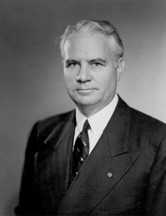John W. Bricker
 | |
| Data i miejsce urodzenia | 1893 Mount Sterling |
|---|---|
| Data i miejsce śmierci | 1986 Columbus |
| 54. Gubernator stanu Ohio | |
| Okres | od 9 stycznia 1939 do 8 stycznia 1945 |
| Przynależność polityczna | Partia Republikańska |
| Poprzednik | Martin L. Davey |
| Następca | Frank J. Lausche |
| Senator Stanów Zjednoczonych z Ohio Klasa 1 | |
| Okres | od 3 stycznia 1947 do 3 stycznia 1959 |
| Poprzednik | Kingsley A. Taft |
| Następca | Stephen M. Young |
| Kandydat Partii Republikańskiej na urząd wiceprezydenta w 1944 (porażka) | |
| Poprzednik | Charles L. McNary |
| Następca | Earl Warren |
John William Bricker (ur. 6 września 1893 w hrabstwie Madison, zm. 22 marca 1986 w Columbus) – amerykański polityk, republikanin ze stanu Ohio.
Urodzony na farmie nieopodal Mount Sterling w swoim rodzinnym Ohio. Ukończył stanowy uniwersytet w roku 1916, przy czym do palestry przyjęto do rok później.
W czasie I wojny światowej służył w armii jako porucznik (1917-1918). Po demobilizacji w latach 1920-1927 był asystentem stanowego prokuratora generalnego, zaś w latach 1933-1937 prokuratorem generalnym.
W roku 1938 wybrano go po raz pierwszy gubernatorem Ohio, który to urząd zajmował przez trzy dwuletnie kadencje (1939-1945).
W roku 1944 kandydat Partii Republikańskiej na urząd prezydenta USA Thomas Dewey mianował go swoim kandydatem na urząd wiceprezydenta. Ale tandem Dewey-Bricker przegrał z ówczesnym lokatorem Białego Domu Franklinem D. Rooseveltem i senatorem z Missouri Harrym Trumanem.
Jednakże porażka wyborcza nie położyła kresu karierze Brickera, który w roku 1946 (zaprzysiężony został w styczniu 1947) został wybrany reprezentantem Ohio w Senacie USA, gdzie zasiadał do roku 1959. W czasie swojej kadencji próbował uzupełnić Konstytucję USA poprawką ograniczającą uprawnienia Prezydenta do zawierania sojuszów (poprawka Brickera).
Republikanie odmówili mu ponownej nominacji w roku 1958. Po porażce Bricker powrócił do Ohio, gdzie praktykował jako prawnik. Zmarł w Columbus.
Był żonaty z Harrier D. Bricker.
Linki zewnętrzne
- Biografia w Biographical Directory of the United States Congress (ang.)
Media użyte na tej stronie
Logo of the Connecticut Republican Party
Seal of the Vice President of the United States. The blazon is defined in Executive Order 11884 as:
The design is the same as the Seal of the President of the United States, except that there is no ring of stars, the clouds are gray (instead of proper), the stars are gray (instead of argent), the scroll is gray (instead of white), the arrows are gray (instead of proper), and the background colors and inscription (obviously) differ.The Coat of Arms of the Vice President of the United States shall be of the following design:
SHIELD: Paleways of thirteen pieces argent and gules, a chief azure; upon the breast of an American eagle displayed holding in his dexter talon an olive branch proper and in his sinister a bundle of thirteen arrows gray, and in his beak a gray scroll inscribed "E PLURIBUS UNUM" sable.
CREST: Behind and above the eagle a radiating glory or, on which appears an arc of thirteen cloud puffs gray, and a constellation of thirteen mullets gray.
The Seal of the Vice President of the United States shall consist of the Coat of Arms encircled by the words "Vice President of the United States."



